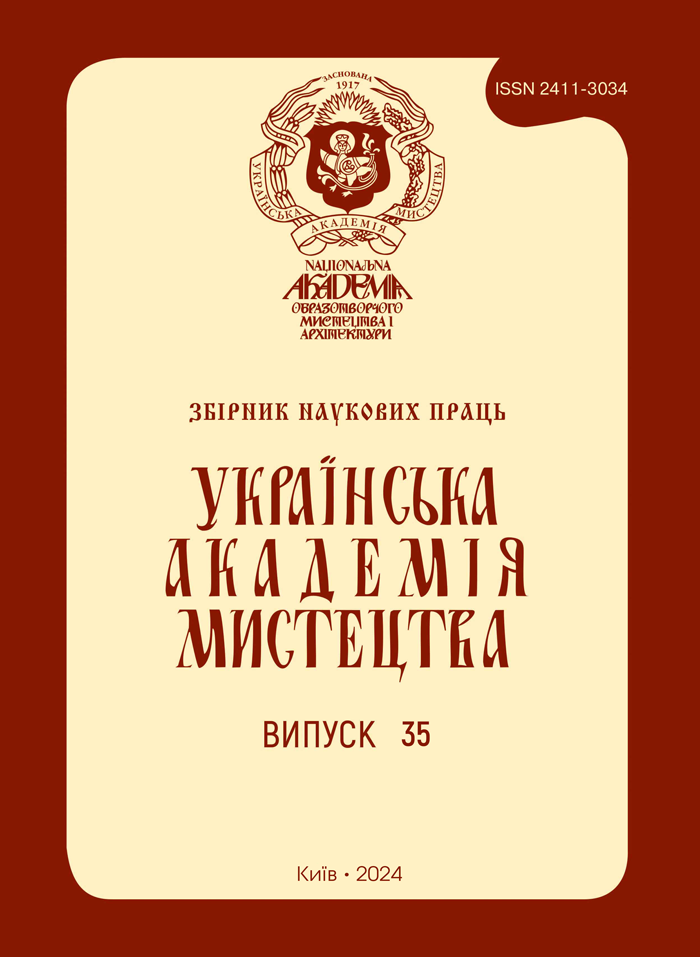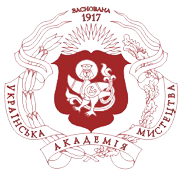THE UKRAINIAN ART OF THE 20TH – EARLY 21ST CENTURIES: AN ATTEMPT TO IDENTIFY THE NATIONAL CONTEXT
DOI:
https://doi.org/10.32782/2411-3034-2024-35-8Keywords:
Ukrainian modernism, Ukrainian avant-garde, artistic academic education, academism, nonconformism, ‘Picturesque reserve’, ‘Southern Ukrainian wave’, U krainian art of the 20th centuryAbstract
The article attempts to identify certain features inherent in modern Ukrainian art, which is caused by the need to understand those distinctive features by which it can be recognized in the world context. Relevance of research. Against the background of the processes of Ukraine's integration into the world cultural and artistic space, in connection with the need to fight for own right to national identity and demonstrate own achievements, natural questions arise: what is the uniqueness of modern Ukrainian art and what is its contextual model. The purpose of the study is to research the historical and cultural basis of the modern Ukrainian art formation, to outline the vectors of development and to find the features that distinguish national art in the world context. Research methods. The research methodology is based on a combination of general scientific, historical, cultural and art studies methods. Research results. The attention is focused on the significant achievements of Ukrainian artists of the academic and realistic school, which span from the end of the 19th century and until today. Thanks to thorough art education in Ukraine, strong foundations for high-quality academic and classical art education have historically been formed. Respectively, for Ukrainian artists until now, classic realistic forms of art are much closer, and Ukraine in international artistic context continues to be mostly associated with the academic and realistic school. Against the background of the modern visual practices development, Ukrainian art is also close to the art directions of European modernism of the beginning of the 20th century. In particular, post-impressionism, abstractionism and other modernist currents are still relevant methods of work. The innovative possibilities of the modernism aesthetics in Ukraine were deeply rethought on a national basis and are used to update the national outlook. Despite the fact that art of modernist trends occupies a significant place in the modern Ukrainian cultural context, in general, there is still a greater tendency towards objectivity. Ukrainian artists concentrate much more on materiality and sensuality than on objectlessness and incorporeality; they are characterized by picturesqueness, melodiousness, special importance is given to colour. Artists turn to plasticity as a means of artistic expression, to work with textures. Tendency of ideology, expansion of content with additional meanings, symbolic images or structural-plastic solutions is also highlighted, which refers to the art of non-conformism, to ‘silent’ protest and experiments of artists in times of total control over creative expression. Today, young artists in Ukraine broadcast Ukrainian uniqueness to the world and raise important issues of national identification. Currently, the following trends can be traced in creativity in various forms: vector of ‘great ideas and contents’ associated with academic school; vector of special sensuality and introspection, which gravitates to visual language of Ukrainian non-conformists; vector of artistic forms and tools of abstractionism, dominance of rhythm and pictorial plasticity, which is attributed to reflections of avant-garde; conceptual, spatial-installational and performative vector (the latter is almost not characteristic of Ukrainian art). Conclusions. Conclusions are made about the recognizable cultural trace characteristic of Ukrainian art. Uniqueness of Ukrainian art lies in its synthetic nature, in organic combination of strong academic traditions and innovation. On the one hand, Ukrainian art is strongly connected with achievements of the academic school artists. On the other hand, with the art of modernism development and Ukrainian avant-garde in the first third of the 20th century, achievements of which are consonant with our turbulent times. A special feature of Ukrainian art is its idealism, expansion of content with additional meanings, which is encoded in symbolic images or structural and colour solutions. At the end of the 1980s, in Ukrainian cultural environment, there was an experience of learning and integrating the directions of postmodernism, in particular, conceptualism and trans-avant-garde. The synthesis of such diverse phenomena became a platform for the formation of original ways of Ukrainian art in the 20th – 21st centuries.
References
Pavlenko, V., Kelm, N., & Nabozhniak, O. (2023, Traven 05). Vkradeni Rosiieiu. Yak Ukraina povertaie imena svoikh khudozhnykiv u svitovykh muzeiakh [Stolen by Russia. How Ukraine returns the names of its artists in world museums]. Texty.org.ua. http://surl.li/tyhsn [in Ukrainian].
Babunych, Yu. (2015). Modernizm i poshuky novykh pryntsypiv formotvorennia v ukrainskomu zhyvopysi kintsia XIX – pershoi tretyny XX st. [Modernism and the search for new principles of form formation in Ukrainian painting of the end of the 19th – the first third of the 20th century]. Visnyk Lvivskoi natsionalnoi akademii mystetstv [Bulletin of the Lviv National Academy of Arts], 26, 128–141. http://nbuv.gov.ua/UJRN/Vlnam_2015_26_16 [in Ukrainian].
Babunych, Yu. (2018). Ukrainskyi zhyvopys doby modernizmu: natsionalne ta internatsionalne v abstraktsionizmi ta konstruktyvizmi [Ukrainian painting of the age of modernism: national and international in abstractionism and constructivism]. Visnyk Lvivskoi natsionalnoi akademii mystetstv [Bulletin of the Lviv National Academy of Arts], 37, 21–33. http://surl.li/tyjqo [in Ukrainian].
Babunych, Yu. (2023). Teoretychnyi dyskurs modernizmu: Ukraina ta yevropeiskyi konteksti [Theoretical discourse of modernism: Ukraine and the European context]. Narodoznavchi zoshyty [Ethnological notes], 3 (171), 665–670. https://nz.lviv.ua/archiv/2023-3/15.pdf [in Ukrainian].
Dubrivna, A. P. (2016). Starodavnia obrazotvorcha kultura yak pershoosnova abstraktnoho mystetstva Ukrainy [Ancient visual culture as the primary basis of abstract art of Ukraine]. Mystetstvoznavchi zapysky [Art history notes], 29, 209–218. http://nbuv.gov.ua/UJRN/Mz_2016_29_26 [in Ukrainian].
Instytut problem suchasnoho mystetstva AMU. (2013). Suchasni problemy khudozhnoi osvity v Ukraini : zbirnyk naukovykh prats [Modern problems of art education in Ukraine : Collection. of science works], (9). Feniks [in Ukrainian].
Shmahalo, R. T. (2013). Mystetska osvita y mystetstvo v kulturotvorchomu protsesi Ukrainy 20–21 st. [Art education and art in the cultural process of Ukraine in the 20th-21st centuries]. LNAM; Mandrivets [in Ukrainian].
Nebesnyk I. (2000). Khudozhnia osvita na Zakarpatti u KhKh stolitti: istoryko-pedahohichnyi aspekt [Art education in Transcarpathia in the 20th century: historical and pedagogical aspect] [Monohrafiia]. Zakarpattia [in Ukrainian].
Kravchenko Ya. O. (2005). Shkola Mykhaila Boichuka. Okhrim Kravchenko. Khudozhnyk i chas [The Mykhailo Boychuk School. Okhrim Kravchenko. Artist and Time]. Oranta [in Ukrainian].
Kryvolapov, M. O. (2006). Pro mystetstvo ta khudozhniu krytyku Ukrainy KhKh stolittia : vybrani statti riznykh rokiv [About art and artistic criticism of Ukraine of the 20th century: Selected articles from different years]: Kn. 1. Formuvannia ta rozvytok natsionalnoi mystetskoi shkoly i mystetstvoznavchoi nauky v Ukraini 20 st. [Formation and development of the national art school and art science in Ukraine in the 20th century]. A+S [in Ukrainian].
Skliarenko, H. Ya. (2007). Na berehakh. Notatky do ukrainskoho mystetstva 20 st. : zbirnyk statei [On the shores. Notes on Ukrainian art of the 20th century coll. articles]. Sofiia-A [in Ukrainian].
Rohotchenko, O. O. (2007). Sotsialistychnyi realizm i totalitaryzm [Socialist Realism and Totalitarianism]. Feniks [in Ukrainian].
Smyrna, L. V. (2017). Stolittia nonkonformizmu v ukrainskomu vizualnomu mystetstvi [A century of nonconformism in Ukrainian visual art] [Monohrafiia]. Feniks [in Ukrainian].
Helman, M. (2021, Sichen 28). Khronolohiia stosunkiv z ukrainskym kontekstom [Chronology of relations with the Ukrainian context] [Interviu] / Interviuer: Lina Romanukha. YOUR ART. https://supportyourart.com/conversations/marat-gelman-hronologiya-stosunkiv-z-ukrayinskym-kontekstom/[in Ukrainian].
Kalyta, N. (2019, Lypen 02). Shcho potribno znaty pro vystavku Nikity Kadana u MUMOK? [What do you need to know about Nikita Kadan’s exhibition at MUMOK?]. YOUR ART. https://supportyourart.com/stories/kadanruin/ [in Ukrainian].
Kriukova, A. O., Kriuk, O. O., & Mostovshchykova, D. O. (2020). Vytoky formuvannia natsionalnoho styliu v ukrainskomu obrazotvorchomu mystetstvi 20 – pochatku 21 stolittia [The origins of the formation of the national style in Ukrainian fine art of the 20th – early 21st centuries]. ΛΌHOΣ. Onlain, (8), 1–7. http://surl.li/tykcd [in Ukrainian].




